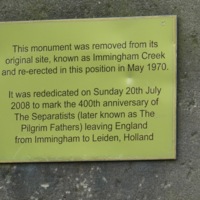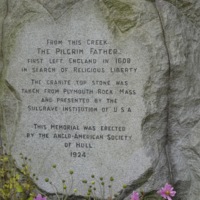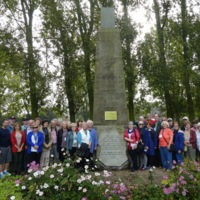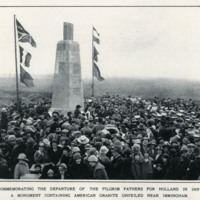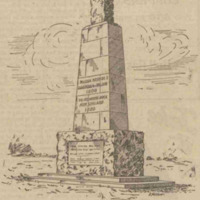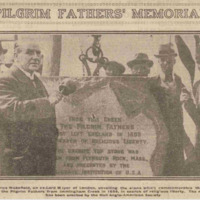Description
Immingham, in Lincolnshire, lies on the southern bank of the Humber Estuary. Between 1841 and 1901, the population of the village barely increased, staying at a constant of around 220-240 people. But the construction of the Immingham Docks (1906-1912), directed by the Great Central Railway, led to a large jump in population in the area – up to 2,681 in 1911.
Toward the end of the nineteenth century, it became common received wisdom that this general area was the place from which some of the Pilgrim Fathers had escaped for Holland in 1608. William Bradford had recorded in his 17th century manuscript history that the boat had moored ‘in between Grimsby and Hull, where was a large commone a good way distante from any towne’. Already, in the 1880s, there was a vague sense that Stallingborough – just south of Immingham – was associated with the story: an article in the Hull Packet described (partly erroneously) that ‘a number of Puritans embarked at the haven in the historic ship, the May Flower [sic]’.
In 1897, the historian Edward Arber made a different suggestion: ‘local opinion’, he said, ‘would seem to favour East Halton Skitter haven… because it is the only break in the specified coast line of Lincolnshire viz between Hull and Great Grimsby’. That same year, George T. Coster – a Congregationalist reverend in Hessle, five miles from Hull – said he could ‘discover no traditions’ about where the Pilgrims had left from, so visited the area: ‘after investigation’ he and a friend ‘concluded that the place of the Pilgrims’’ attempted embarkation was not, as Professor Arber thinks, East Halton, Skitter Haven, but Immingham Creek.’ In 1901, Rev J.E. Shephard (a Baptist active in Hull) gave a local lecture about ‘the lives of the early Nonconformists, illustrating his remarks with specially prepared views of scenes of their labours’ – including ‘Killingholme Haven on the Humber’, just south of Immingham, which he said was ‘the embarking place of some of the refugees’.
Many historians and reverends were thus making guesses. Probably the most accurate hypothesis, however, came from the father and son team of Henry and Morton Dexter. In 1905, they said that Stallingborough ‘seems to meet the conditions best’ – bolstering their claim with the fact that ‘Nun’s Creek, which the stream bears, may be due to some derisive or blundering association of the spot with its sheltering’ of the ‘persecuted company of women’ left behind after the escape attempt. As historian Nick Bunker has shown more recently, using records (Calendars of State Papers) that were either unknown or unused by most historians (though possibly not the Dexters), Stallingborough was indeed the site.
To a degree, the exact location did not really matter; it was more that, in general, local people could make a claim to historical importance. In 1914, the vicar of Immingham – Rev Miller Reid – was one of the first to try and draw on the cultural memory of the launch site. Realising that the Anglo-American Centenary Peace Committee were interested in erecting memorials to the Pilgrim Fathers, and making a spurious claim that ‘Immingham was the parish in which some of them last worshipped’, he travelled to New York looking for £2,000 to restore the Parish Church as one such memorial. Promises for the whole amount were apparently made, but, unfortunately, the First World War intervened, and the project was cancelled.
When the 300th anniversary arrived in 1920 however, Killingholme Creek was a part of the celebrations. A civic party from Hull took the steam yacht to Immingham Docks, and the Rev. W. Graham Bell led an ‘open air commemoration service’ before the Rev. J.G. Patton gave a ‘commemorative address’. One man heavily involved in organising Hull’s tercentenary activities was local businessman and Congregationalist Charles Wray. In 1922, he was the leading figure behind the setting up of the Hull branch of the Anglo-American Society – an older organisation given a new lease of life by the Washington Naval Conference (1921-2) that, as one objective, aimed to reduce tensions between the two powers. As the Hull Daily Mail put it, in an article headed ‘Hands Across the Sea’, the ‘future of the world’ depended ‘upon the whole English-speaking race standing together in the cause of world peace’ something would ‘only be possible by unremitting efforts to foster friendship between English-speaking nations.’ The Sulgrave Institution, another Anglo-American organisation, sent a block of granite from Plymouth, Massachusetts to be used in a new monument – a leftover piece from the original canopy covering Plymouth Rock (built in 1867, and taken down for a new canopy in 1920).
In 1924, the stone for the memorial was laid by Sir Charles Wakefield, ex Lord Mayor of London and one of the founders of the Anglo-American Society. Around 1,000 people, including Americans from the American cadet Ship Nantucket, gathered to see the unveiling and hear the speeches. The Lord Mayor of Hull, E. Keighley, hoped the monument ‘would help to cement the friendship between the two countries’, whereas Margaret Wintringham (MP for the Division) said it was ‘another link between America and England’. Wakefield, in the main address, celebrated the Pilgrims as ‘devout and earnest men; home-loving, hard-working men, the very pattern of good citizenship.’ It was, he said,
the most glorious confirmation of their faith that they became the founders of the powerful and free United States of America, and that wherever the English tongue was spoken – wherever, indeed, liberty was held in honour and religion a living faith – the example of the Pilgrim Fathers was an ever-present inspiration.
Rev Patton offered a dedicatory prayer, and a descendant of William Bradford (one of the visiting cadets) laid a wreath; singing of hymns and national anthems followed. In September 1925, the completed monument was unveiled by the Lord Mayor of Hull after a procession from Killingholme Creek by the Mayor, civic guests, and visiting Americans.
By the early 1960s, with the postwar expansion of nearby Immingham Docks, there were concerns raised about the preservation of the monument – not unfounded, given that some damage had already taken place. As the county surveyor put it, the monument was ‘not too accessible’ and looked ‘out of place beside an insignificant creek being gradually filled in and dwarfed and crowded in by recently erected fuel tanks and butane gas storage cylinders.’ The Anglo-American Society of hull was defunct, so a joint committee (with representatives from the Lincolnshire branch of the Historical Association, Lincoln Archaeological Research Committee, Lincolnshire Architectural and Archaeological Society, and the Council for the Preservation of Rural England) organised to protect the monument. In 1966, a public meeting was organised by Immingham Parish Council to consider the future of the monument; eventually, it was decided to relocate it to the parish church, unveiled in 1970 to coincide with the 350th anniversary of the Mayflower voyage.
Source
‘Immingham and the Pilgrim Fathers’, Hull Daily Mail (17 April 1914), 5.
‘Local “Pilgrim Fathers”’, Hull Daily Mail (3 September 1920), 3
‘Hands across the sea’, Hull Daily Mail (1 December 1922), 4.
Statistical data about Immingham - https://www.visionofbritain.org.uk/unit/10426790/cube/TOT_POP
Letter from ‘A parishioner of Immingham’, Hull Daily Mail (24 July 1924), 7.
‘Stone-laying at Immingham’, Hull Daily Mail (31 July 1924), 8.
‘Pilgrim Fathers’ Monument’, Yorkshire Post and Leeds Intelligencer (1st August 1924), 12.
G. Patton, Memorial to the Pilgrim Fathers at Immingham Creek (unveiled Sept., 17th, 1925): An Address (1925).Lincoln, Lincolnshire Archives, 7-LCL/20: Records Relating to the Immingham Pilgrim Fathers' Monument
‘Homes and haunts of the Pilgrim Fathers’, Hull Daily Mail (17 December 1901), 3.
Nick Bunker, Making Haste from Babylon: The Mayflower Pilgrims and Their World (London, 2011), 189-201.

